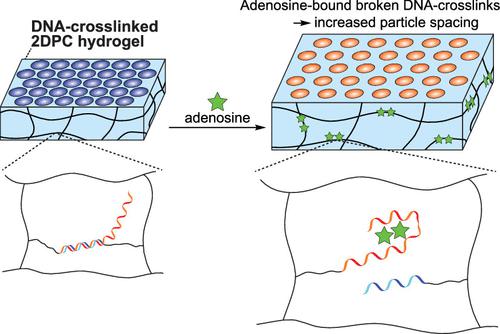Our official English website, www.x-mol.net, welcomes your
feedback! (Note: you will need to create a separate account there.)
DNA-Crosslinked 2D Photonic Crystal Hydrogels for Detection of Adenosine Actuated by an Adenosine-Binding Aptamer
ACS Sensors ( IF 8.2 ) Pub Date : 2022-05-27 , DOI: 10.1021/acssensors.1c02424 Kyeongwoo Jang 1 , James H Westbay 1 , Sanford A Asher 1
ACS Sensors ( IF 8.2 ) Pub Date : 2022-05-27 , DOI: 10.1021/acssensors.1c02424 Kyeongwoo Jang 1 , James H Westbay 1 , Sanford A Asher 1
Affiliation

|
There is a need to develop versatile sensing motifs that can be used to detect a variety of chemical targets in resource-limited settings, for example, at the point of care. While numerous sensing technologies have been developed toward this effort, these technologies can be overly complex and require a skilled technician, extensive sample preparation, or sophisticated instrumentation to use, limiting their generalizability and application in resource-limited settings. Here, we report a novel sensing motif that utilizes DNA-crosslinked two-dimensional photonic crystal (2DPC) hydrogels. These hydrogel sensors contain a DNA aptamer recognition group that binds a target analyte. As proof of concept, we fabricated 2DPC hydrogels using a well-studied adenosine-binding aptamer. This adenosine aptamer is duplexed with a partially complementary strand and forms responsive crosslinks in the hydrogel polymer network. When adenosine is introduced, aptamer–adenosine binding occurs, breaking the DNA crosslinks and causing the hydrogel to swell. This in turn increases the particle spacing of an embedded 2DPC array, shifting the 2DPC Bragg diffraction. Thus, adenosine concentration can be monitored through 2DPC Bragg diffraction measurements. A linear range of 20 μM to 2 mM was observed. The detection limits were calculated to be 13.9 μM in adenosine-binding buffer and 26.7 μM in fetal bovine serum. This reported sensing motif has a readout that is simple and rapid and requires minimal equipment. We hypothesize that this sensing motif is generalizable and that other sensors can be easily fabricated by simply exchanging the aptamer that serves as a molecular recognition group.
中文翻译:

DNA 交联二维光子晶体水凝胶用于检测由腺苷结合适体驱动的腺苷
需要开发通用的传感基序,可用于在资源有限的环境中检测各种化学目标,例如在护理点。尽管已经为此努力开发了许多传感技术,但这些技术可能过于复杂,需要熟练的技术人员、大量的样品制备或复杂的仪器才能使用,从而限制了它们在资源有限环境中的普遍性和应用。在这里,我们报告了一种利用 DNA 交联二维光子晶体 (2DPC) 水凝胶的新型传感基序。这些水凝胶传感器包含一个与目标分析物结合的 DNA 适配体识别基团。作为概念证明,我们使用经过充分研究的腺苷结合适体制造了 2DPC 水凝胶。这种腺苷适体与部分互补链双链,并在水凝胶聚合物网络中形成响应性交联。当引入腺苷时,会发生适体-腺苷结合,破坏 DNA 交联并导致水凝胶膨胀。这反过来又增加了嵌入式 2DPC 阵列的粒子间距,从而改变了 2DPC 布拉格衍射。因此,可以通过 2DPC 布拉格衍射测量来监测腺苷浓度。观察到 20 μM 至 2 mM 的线性范围。经计算,检测限在腺苷结合缓冲液中为 13.9 μM,在胎牛血清中为 26.7 μM。该报告的传感主题具有简单快速的读数,并且需要最少的设备。
更新日期:2022-05-27
中文翻译:

DNA 交联二维光子晶体水凝胶用于检测由腺苷结合适体驱动的腺苷
需要开发通用的传感基序,可用于在资源有限的环境中检测各种化学目标,例如在护理点。尽管已经为此努力开发了许多传感技术,但这些技术可能过于复杂,需要熟练的技术人员、大量的样品制备或复杂的仪器才能使用,从而限制了它们在资源有限环境中的普遍性和应用。在这里,我们报告了一种利用 DNA 交联二维光子晶体 (2DPC) 水凝胶的新型传感基序。这些水凝胶传感器包含一个与目标分析物结合的 DNA 适配体识别基团。作为概念证明,我们使用经过充分研究的腺苷结合适体制造了 2DPC 水凝胶。这种腺苷适体与部分互补链双链,并在水凝胶聚合物网络中形成响应性交联。当引入腺苷时,会发生适体-腺苷结合,破坏 DNA 交联并导致水凝胶膨胀。这反过来又增加了嵌入式 2DPC 阵列的粒子间距,从而改变了 2DPC 布拉格衍射。因此,可以通过 2DPC 布拉格衍射测量来监测腺苷浓度。观察到 20 μM 至 2 mM 的线性范围。经计算,检测限在腺苷结合缓冲液中为 13.9 μM,在胎牛血清中为 26.7 μM。该报告的传感主题具有简单快速的读数,并且需要最少的设备。











































 京公网安备 11010802027423号
京公网安备 11010802027423号